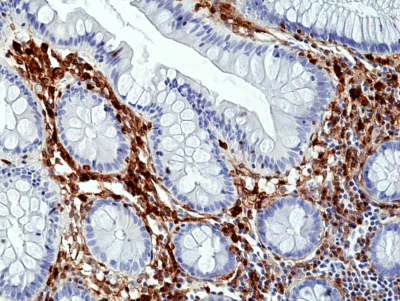
anti-Annexin A1 (human), Rabbit Monoclonal (RM424)
REV-31-1311-00
ApplicationsWestern Blot, ImmunoHistoChemistry
Product group Antibodies
ReactivityHuman
TargetANXA1
Overview
- SupplierRevMAb Biosciences
- Product Nameanti-Annexin A1 (human), Rabbit Monoclonal (RM424)
- Delivery Days Customer10
- ApplicationsWestern Blot, ImmunoHistoChemistry
- CertificationResearch Use Only
- ClonalityMonoclonal
- Clone IDRM424
- Gene ID301
- Target nameANXA1
- Target descriptionannexin A1
- Target synonymsANX1, LPC1, annexin A1, annexin I (lipocortin I), annexin-1, calpactin II, calpactin-2, chromobindin-9, epididymis secretory sperm binding protein, phospholipase A2 inhibitory protein
- HostRabbit
- IsotypeIgG
- Protein IDP04083
- Protein NameAnnexin A1
- Scientific DescriptionRecombinant Antibody. This antibody RM424 reacts to human Annexin A1. Application: IHC, WB . Source: Rabbit. Liquid. 50% Glycerol/PBS with 1% BSA and 0.09% sodium azide. The annexin superfamily consists of 13 calcium or calcium and phospholipid binding proteins with high biological and structural homology. Annexin-1 (ANXA1) is the first characterized member of the annexin family of proteins and is able to bind to cellular membranes in a calcium-dependent manner, promoting membrane fusion and endocytosis. Loss of function or expression of this gene has been detected in multiple tumors. Annexin A1 has anti-inflammatory properties and inhibits phospholipase A2 activity, can accumulate on internalized vesicles after EGF-stimulated endocytosis and may be required for a late stage in inward vesiculation. Annexin A1 has also been identified as one of the eat-me signals on apoptotic cells that are to be recognized and ingested by phagocytes. Annexin A1, as an endogenous anti-inflammatory mediator, has roles in many diverse cellular functions, such as membrane aggregation, inflammation, phagocytosis, proliferation, apoptosis and tumorigenesis and cancer development. - The annexin superfamily consists of 13 calcium or calcium and phospholipid binding proteins with high biological and structural homology. Annexin-1 (ANXA1) is the first characterized member of the annexin family of proteins and is able to bind to cellular membranes in a calcium-dependent manner, promoting membrane fusion and endocytosis. Loss of function or expression of this gene has been detected in multiple tumors. Annexin A1 has anti-inflammatory properties and inhibits phospholipase A2 activity, can accumulate on internalized vesicles after EGF-stimulated endocytosis and may be required for a late stage in inward vesiculation. Annexin A1 has also been identified as one of the eat-me signals on apoptotic cells that are to be recognized and ingested by phagocytes. Annexin A1, as an endogenous anti-inflammatory mediator, has roles in many diverse cellular functions, such as membrane aggregation, inflammation, phagocytosis, proliferation, apoptosis and tumorigenesis and cancer development.
- ReactivityHuman
- Storage Instruction-20°C
- UNSPSC12352203






